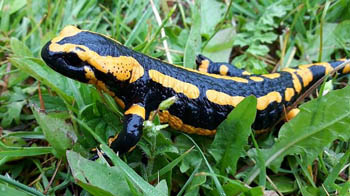ANSWERING THE CRITICS
Speciation, The Proof of Evolution?
Speciation
Speciation Proves Evolution: It's Magic!
By Steve Hudgik
Proponents of evolution claim there is overwhelming evidence proving that evolution is real. When asked to produce that evidence, most often the first thing they'll point to is speciation. In simplistic terms they'll say, “Look at that animal.” Let's say it is a salamander. “Look at that salamander, its ancestors were all gray, now it is a new species that has spots. The salamander has changed. It can no longer breed with its ancestral population. That is evolution.”

Yes, the salamander has changed... but what is it? It is still a salamander. Then they'll say, “With enough changes it will become something else.” However, that step has never been observed nor proven to be true. The opposite is what is actually observed. Salamanders always reproduce more salamanders.
Let's find out what is happening. The problem in talking with evolution proponents is that definitions of words change … sometimes in the middle of a sentence... and a lot of necessary facts are ignored. So let's dig into the details.
First, what is speciation? The official definition is “the formation of new and distinct species.” That's not much help. So what is a species? The encyclopedia Britannica defines a species as, “related organisms that share common characteristics and are capable of interbreeding.”
In the category of newts and salamanders there are 760 species... all of which look a little different, and none of which can interbreed with each other. So we have many different species of salamanders.
Now let's define evolution...
The Merriam-Webster dictionary definition is: descent with modification from preexisting species Hmmm...
Live Science defines evolution as: “The process by which organisms change over time as a result of changes in heritable physical or behavioral traits.” Hmmm...
These are very broad definitions that include practically everything. They make it easy to prove evolution... if something changes in a way that those changes are passed on to the next generation, that is evolution. BUT... does this definition represent what is commonly intended when the word “evolution” is used? Not really. It is much too generic. And that's a big problem...
Evolution claims more than simply inherited changes. It claims that those inherited changes result in new, unique forms of organisms, that have capabilities not seen in any previous organism. For example, fish become amphibians... gaining lungs and the ability to walk on land... among many other changes that are required. Fish have different muscle and bone structures than land animals. For example, fins are not weight bearing... they are attached to soft tissue. To walk on land requires new structures that can support the weight of the animal, such as legs connected to hips and shoulders... components that do not exist in fish.
This means that additional information needs to be added to the genome specifying all the changes needed for adding hips and shoulders, for example. This is called specified complexity. What is that?
Nature can produce complex structures... for example, snow flakes. But, without a designer the complexity is still random. Hips and shoulders are very complex structures, in particular on the molecular level. They must be made correctly, and in the same way, every time. That means their complexity must be specified. Unlike snowflakes that are all different, they have a specified design so they can accomplish a specific purpose -- walking on land in this example. Variation in the structure of hips and shoulders would be harmful. For example, in humans hips dysplasia is caused by a mutation in one copy of the UFSP2 gene. It usually causes severe progressive degenerative, and painful osteoarthritis of the hip joint beginning in early adulthood, and sometimes beginning in infancy. A small change in the specification results in reduced function. That's not good.
The information that specifies hips needs to be correct... or there are problems. This is called specified complexity... the hip must have a specific structure and that means its design must be specified. And that's why, for example, all humans have the same hip structure. It is specified in our genetic information.
What evolution requires is that new (novel), specified complexity comes into existence... somehow... to produce a new organism that would be classified not just as a new species, but as being in a different genus, family or order. Structures that never existed previously, as well as a system that reliably produces those structures, needs to... come from somewhere. There is no evidence that there is any mechanism, such as evolution, that is capable of adding new, specified complexity to an organism.
Instead, the evidence, such as the Cambrian Explosion, shows us that specified complexity was designed into organisms form the beginning.
Getting back to speciation...
What we see in speciation is variation within the same family or genus, for example. We see variations of what already exists. Or variations caused by broken genetic information. We do not see novel specified complexity.
The problem has its root in how the word evolution is used.
In 1960 Dr. Gerald A. Kerkut, a noted British zoologist and physiologist, defined the two very different ways the word evolution is used: he wrote...
“There is a theory which states that many living animals can be observed over the course of time to undergo changes so that new species are formed. This can be called the ‘Special Theory of Evolution’ and can be demonstrated in certain cases by experiments.
On the other hand there is the theory that all the living forms in the world have arisen from a single source which itself came from an inorganic form. This theory can be called the ‘General Theory of Evolution’ and the evidence that supports it is not sufficiently strong to allow us to consider it as anything more than a working hypothesis."
So we see that speciation... the development of new species, is called the Special Theory of Evolution. It shows change, but it shows us nothing about how life got from a single cell organism to all of the different forms of life we see today.
However, when the word “evolution” is used, it is most often is referring to something greater than simply speciation... as Kerkut states, all life arising from a single source. This requires evolution to be capable of adding new, specified complexity. Or what is commonly (but inaccurately) referred to as adding new information to the genome. This has never been observed, nor is there any evidence it has ever happened.
What advocates of evolution are doing is using the same word to describe two different processes. Yes, evolution involves inherited change, and we see that in speciation. But, that's a very broad definition. As we get more precise... evolution... life coming from a single source... requires the development of new, specified complexity. That step has never been shown to happen. The step from speciation, to descent from a common ancestor, has no basis in real science.
What is observed is that specified complexity requires an intelligence to do the specifying. For there to be new structures, such as hips and shoulders, requires that there be a designer who specified what those hips and shoulders would be like.
A scientific proof cannot simply gloss over such a significant step such as the addition of novel specified complexity. Speciation is very limited in what it can accomplish. To demonstrate that the General Theory of Evolution is true, requires proving each step in the process. Nothing can be glossed over... especially a major step as significant as novel specified complexity.
In high school my sophomore math teacher marked an algebra proof wrong, if I did not show every step in the proof. Even if I got the right answer. The proof of evolution fails that very simple criteria. The proof of evolution ignores the step from species to a new genus or family, and assumes it just happens... that new specified complexity arises simply because... well things change. That's not science. That's magic and we don't believe in magic.
THE WIDE OR
NARROW WAY?

Most people choose the wide road. It's the way everyone else is going. It's wide and it's an easy road, so it must be the right road. But it's the wrong way!
Enter through the narrow gate; for the gate is wide and the way is broad that leads to destruction, and there are many who enter through it. For the gate is small and the way is narrow that leads to life, and there are few who find it. - Matthew 7:13
The wide road, and wide gate is our choice based what feels good. But our feelings (our heart) are deceptive.
The heart is more deceitful than all else and is desperately sick; - Jeremiah 17:9
Christianity... meaning belief in Jesus Christ... is not a blind faith driven by emotions. It is an informed faith, based on historical facts and truth.
The truth is that we are law breakers (sinners) in need of a Savior from the just wrath of God. That Savior is Jesus Christ.
Trusting Jesus is not the easy way. It is the narrow road, through a narrow gate, and it can be difficult at times. But it is the right way to go. And it is the only way to have eternal life in Christ Jesus.
Trust Jesus. Believe in the Lord Jesus, and you will be saved. - Acts 16:31
